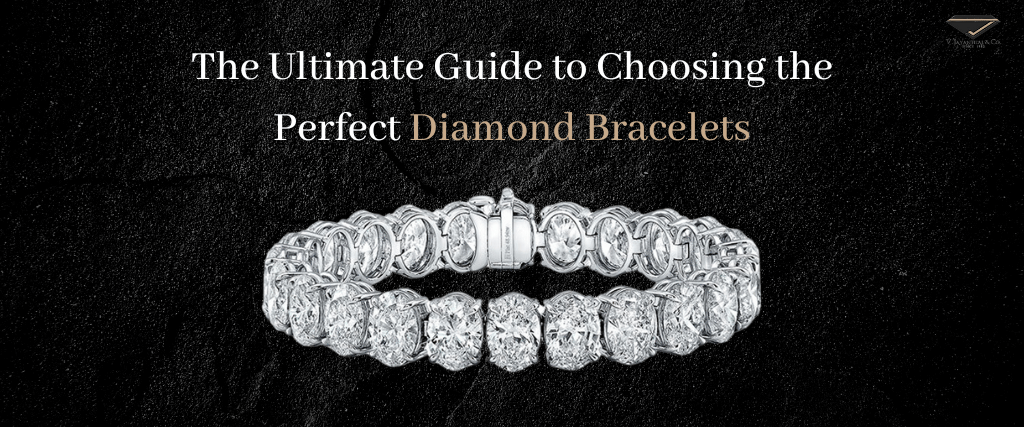
When it comes to stunning jewellery pieces that exude elegance and luxury, few can compare to the splendour and appeal of a bracelet. A quality diamond bracelet will enhance your attire and give you extra confidence as you go through your day.
For centuries, these exquisite accessories have captivated people's hearts. They have transformed from being symbols of power and wealth to turning into beloved manifestations of love and style. In this comprehensive guide, we will take you through everything you need to know before buying a diamond bracelet. Diamond bracelet women are some of the most unique and galvanizing pieces of jewellery available, with the bonus of being capable of admiring their beauty with a simple glance and movement of the wrist.
Whether you’re a first-time buyer or looking to expand your jewellery collection, this article will provide you with valuable insights and expert tips to help you make a knowledgeable choice.
Diamond bracelets are not simply accessories; they are expressions of refined taste and sophistication. Typically crafted with meticulous precision, these elegant pieces feature diamonds as the focal point, creating a dazzling display of brilliance and sparkle.
From traditional designs to cutting-edge masterpieces, diamond bracelets cater to a wide range of tastes and are suitable for lots of occasions, making them a staple in any jewellery collection.
Originally, they had been seen solely as symbols of wealth and status, worn with the aid of royalty and the Aristocracy.
Over time, their reputation grew, and today diamond bracelets have ended up a token of affection, and dedication and function as fantastic gifts for occasions like anniversaries and birthdays.
Before embarking on your look for an appropriate diamond bracelet, it’s crucial to determine your budget. Diamond bracelet prices vary depending on factors such as the size and quality of the diamonds as well as the type of metal used. Keep in mind that, diamonds are related to luxury, and there are options available to suit every price range.
Diamond bracelets come in various styles, each with its own unique charm and aesthetic appeal. Before making your purchase, consider the style that suits your taste and lifestyle. Common bracelet styles include tennis bracelets, bangle bracelets, charm bracelets, cuff bracelets, and more.
To make sure you're investing wisely, it's important to understand the quality of the diamonds in a bracelet. A diamond's overall quality and value are largely determined by its carat weight, cut, clarity, and color.
1. Cut: The cut refers to how well a diamond has been shaped and faceted. A well-cut diamond reflects light beautifully, maximizing its brilliance and sparkle. Round diamond bracelets are very popular in the market. It is considered to be the most popular and classic shape that you can have. The oval diamond bracelet is considered to be very elegant, and it is also very popular among celebrities.
2. Clarity: Any internal or external flaws, referred to as inclusions or blemishes, respectively, are measured for clarity. The clarity grade ranges from flawless (no imperfections visible under 10x magnification) to included (visible flaws with the naked eye).
3. Color: A colour scale ranging from D (colourless) to Z (light yellow or brown) is used to grade diamonds. More coloured diamonds are less expensive, but colourless diamonds are thought to be the most valuable and desirable.
4. Carat Weight: The term "carat weight" describes the diamond's size. It’s important to note that carat weight alone does not determine a diamond’s quality. A larger carat weight with lower cut, clarity, and color grades may not be as desirable as a smaller diamond with higher grades.
By understanding the different types of diamond bracelets, choosing the right metal, and evaluating diamond quality based on the four Cs, you’ll be equipped with the knowledge needed to make an informed decision when purchasing a diamond bracelet.
Diamond cuts play a significant role in the overall appearance and brilliance of jewellery, including bracelets. Let's delve into the details of the popular diamond cuts:
The round cut is the most popular and classic of all diamond shapes. It features a circular outline with 58 facets, maximizing brilliance and fire. Round diamonds are versatile and can be used in various bracelet designs, from delicate tennis bracelets to more intricate designs with multiple stones.
Oval-cut diamonds are characterized by their elongated shape with rounded edges. They typically have 56 to 58 facets, similar to round cuts, which provide excellent brilliance. Oval-cut diamonds in bracelets often create a sleek and elegant look. Oval diamonds are suitable for both single-stone bracelets and designs with multiple stones, offering a unique twist on traditional round-cut bracelets.
The emerald cut is known for its rectangular shape with trimmed corners, creating a hall-of-mirrors effect due to its large, open facets. It typically has 50 to 58 facets. Emerald-cut diamonds lend a sophisticated and vintage-inspired look to bracelets. Emerald diamonds are often used in combination with other diamond shapes or as the focal point in a bracelet design, providing a timeless elegance.
The cushion cut, also known as the pillow cut, features rounded corners and larger facets, giving it a soft and romantic appearance. It typically has 58 facets. Cushion-cut diamonds add a touch of vintage charm to bracelet designs. Whether set individually or in clusters, the cushion diamond bracelet creates a beautiful and eye-catching look, blending classic appeal with modern flair.
When choosing a diamond cut for a bracelet, consider factors such as personal preference, style, and desired aesthetic. Each cut offers its unique charm and brilliance, allowing you to find the perfect match for your jewelry collection.
Many different styles of diamond bracelets cater to a wide variety of tastes. There is a wide range of options, from the classic tennis bracelet to the striking and modern bangle. The delicate chain bracelet, the Art Deco bracelet with a vintage feel, and the contemporary charm bracelet are other popular designs. Let's examine each style in greater detail and recognise the subtle differences between them:
Bold Brilliance Let your wrist make a statement with the bold and glamorous bangle bracelet. Its rigid design, often enhanced with brilliant cut diamonds, exudes confidence and adds a touch of grandeur to any occasion. Unleash your inner diva with this striking accessory. They are simple and elegant and can feature one or more diamonds in the band. Bangle bracelets can be worn single, or stacked for a more dramatic look
Bold and Unapologetic Make a statement with the cuff bracelet, a bold and unapologetic piece that demands attention. The cuff bracelet, whether it is minimalistic in style or adorned with diamonds, is a statement piece that can take your outfit to new heights. They are stylish bands of precious metal with diamonds set into them.
Modern Simplicity Revel in the beauty of modern simplicity with the link bracelet. With its diamond-studded interlocking links, this style exudes sophistication while maintaining a modern edge, making it a flexible option for any setting. They are designed with a series of links with diamonds set into them. Diamond link bracelets are a classic and stylish choice that can be worn for many occasions. Link bracelets can come in a variety of styles and designs.
Endless Sparkle A diamond tennis bracelet is the epitome of refined elegance, showcasing a continuous row of diamonds that dance gracefully around your wrist. This timeless piece effortlessly complements any ensemble, making it an essential in every jewellery collection. They are a much-loved classic! A diamond tennis bracelet features rows of diamonds, with a prong or bezel setting. They are worn for special occasions but are also suited to wear every day.
A Personal Narrative Let your jewellery tell your story with the charm bracelet. Adorned with diamonds and meaningful charms, this piece becomes a reflection of your journey, capturing cherished moments and sentiments in a sparkling celebration of life. Charm bracelets allow you to add small diamond charms or other meaningful pendants to the bracelet. It’s a perfect option for those who want to create a piece of jewellery that reflects their individuality.
Dalliance Delicate yet versatile, the chain bracelet is a subtle play of diamonds along a slender chain. It offers a refined sparkle that seamlessly transitions from day to night, making it an ideal companion for any style journey.
Retro Glamour Rethought With a bracelet that features geometric designs and elaborate patterns, you can transport yourself to the glitz and glamour of the Art Deco era. This vintage-inspired piece is a nod to the past while adding a touch of sophistication to your modern wardrobe.
Bohemian Chic Embrace a bohemian vibe with the wrap bracelet, a versatile and carefree style that effortlessly coils around your wrist.
The metal used in a diamond bracelet not only affects its appearance but also its durability and maintenance. Here are some common choices:
Gold is a popular choice for diamond bracelets due to its timeless appeal and durability. Halo white gold, yellow gold Depending on skin tone and personal preference, rose gold and bracelets are all great options.
The opulence and toughness of platinum enhance the radiance of diamonds. It is hypoallergenic and offers a lustrous, silvery-white appearance that doesn’t fade over time.
Sterling silver is a more affordable option, often used in diamond bracelets with a lower price range. It offers a bright and shiny appearance but requires regular cleaning and maintenance to prevent tarnishing.
The setting of diamonds plays a crucial role in the overall appeal of a diamond bracelet so it’s important to keep this in mind before you make a purchase. It's helpful to know that certain settings can even enhance the piece's brilliance and durability, particularly if you're thinking about purchasing one as an investment. The following are a few of the most common setting types:
Taking Up Light The prong setting is a real winner when it comes to letting the diamonds take centre stage. With minimal metal interference, small claws secure each diamond in place, creating an illusion of suspended radiance. This configuration maximises the diamond's exposure, letting light dance around it and bring out all of its brilliance.
A Smooth Acceptance Imagine a sleek, safe embrace; that is the bezel setting's allure. Here, diamonds are cradled within a metal rim, providing both protection and a contemporary aesthetic. This setting not only accentuates the individuality of each diamond but also adds a touch of modern sophistication to the overall diamond bracelet design.
Uninterrupted Harmony Amongst all the settings, the channel setting exudes a sense of uninterrupted harmony. Two parallel strips of metal are nested with diamonds to form a smooth, continuous surface. This setting not only enhances the bracelet's sleek appearance but also ensures a seamless flow of brilliance, creating a visual symphony of sparkle.
The Paved Path to Opulence For those who appreciate opulence, the pave setting is a masterpiece. The surface is covered in tiny diamonds that have been painstakingly placed closely together to resemble a brilliantly paved path. This technique not only maximises the overall sparkle but also imparts a luxurious texture to the bracelet, creating a captivating tapestry of shimmering diamonds.
A Blooming Arrangement The magic of the cluster setting is best illustrated by picturing a bouquet of diamonds encrusted on your wrist. The skilful clustering of several diamonds produces the appearance of a blooming floral arrangement. This setting adds a touch of whimsy and elegance, making it a delightful choice for those who seek a distinctive and playful look.
In summary, purchasing a diamond bracelet involves a sizable emotional and financial commitment. It is crucial to take your time, do your research, and consider all the important factors before deciding. By following the guidelines in this ultimate guide, you can confidently navigate the world of diamond bracelets and find the perfect piece of jewellery that will bring joy and elegance to your life for years to come. At V. Jayantilal & Co., we're committed to providing our customers with the highest quality diamonds of different shapes such as oval, round, emerald, and cushion that are backed by exceptional customer service and expertise.
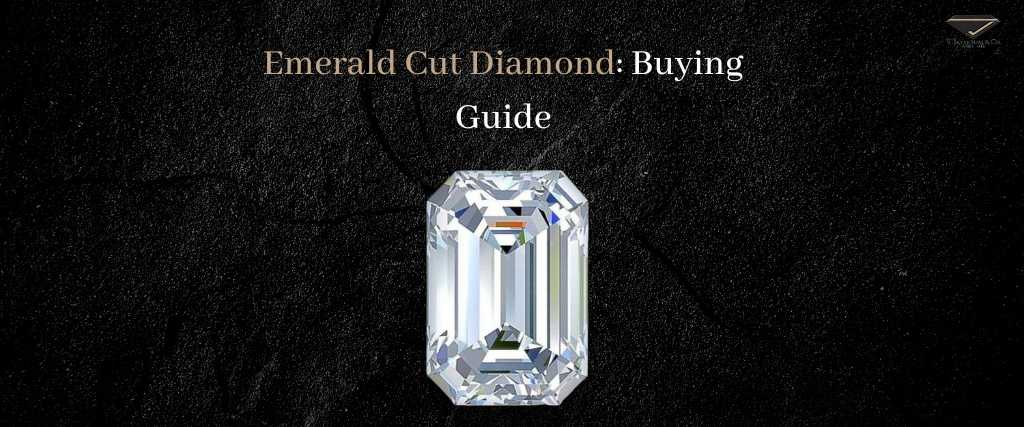
Suppose you’re after a unique and timeless piece of jewellery. In that case, emerald-cut diamonds serve as an alternative to a traditional round-cut diamond, all while offering elegance and sophistication to your jewellery collection. Emerald cut diamonds are instantly recognizable by their elongated, rectangular shape and ‘step cut’ facets that provide a ‘hall of mirrors’ effect.
Loose emerald-cut diamonds are the perfect centerpiece for most types of jewellery, from earrings or necklaces to captivating emerald-cut engagement rings.
Emerald cut diamonds have a long rectangular shape and parallel facets, offering a more distinctive appearance than other types of diamonds. They are renowned for their retro aesthetic and bursts of light because of their linear, straight facets. An emerald-cut diamond typically has its corners trimmed to increase stability and avoid fractures.
Emerald cuts are frequently employed to display value because their big, open facets make the color of the stone appear more clearly. Embellished with emerald-cut diamonds, celebrities who want to show off their wealth usually do so.
A wide surface table and deep clarity are features of the emerald-cut diamond. The diamond offers many reflections of both white and colored light because of its lengthy step cuts. Although they are also available in squares, emerald cuts are more noticeable in rectangles.
Unlike the sparkle you would expect from rounder diamonds, an emerald cut offers reflections of white and colored light for a more subtle shimmer. They come in square form as well as the more common rectangular shape.
Emerald-cut diamonds frequently show their color clearly due to their large, open facets. However, you should bear in mind that color evaluation is subjective, and your acuity would differ from another person’s.
In order to see no yellow tinge in your diamond, if you are a color-sensitive person, you might want to consider a higher color (D-G).
A lot of buyers choose emerald-cut diamonds because of their timeless appeal. If you are someone who loves vintage-style jewellery, it is perfectly fine for you to go down to J or even K colors where the diamonds show a warm tint.
Large stepped surfaces on emerald cuts can make even the smallest body flaws in the diamond visible. Due to the nature of their step-cutting style, they have less brilliance and scintillation and generally require a higher clarity rating to stay eye-clean.
In general, I would recommend VS2 clarity as the “Goldilocks” rating to get an eye-clean diamond without having to pay the premium for higher clarity grades. But do take note that as you go larger in carat size, you will need a higher clarity grade for the diamond to stay eye-clean.
The bottom line is that you need to exercise caution when buying emerald-cut diamonds of a lower clarity grade.
No matter where you purchase it, you must examine the diamond under magnification in impartial, neutral lighting. As much as possible, I also recommend inspecting the diamond from as many angles as possible to check for eye cleanliness.
Although emerald cuts go well with many different styles, they really shine in settings that are more understated.
The center of the diamond is held in place by tiny prongs that protrude from the ring band in a solitaire setting, a traditional design choice for an emerald-cut ring.
A three-stone setting involves two diamonds or gems on either side and an emerald cut stone in the centre, as the name suggests. Due to the extra sparkle on either side of the diamond, a three-stone setting is a way to add more carat weight and value to the ring.
If you want to add more sparkle to the ring, you could choose a halo setting, which offers small accent stones around the diamond cut centre stone—perfect for those looking for extra glamour.
An east-west setting is a great way to go for the unexpected if you're looking to break with tradition! The diamond's appearance is changed by this setting because it rests horizontally on the band.
A bezel-style emerald cut engagement ring is resurfacing as a desirable ring characteristic for modern brides.
An emerald-cut diamond can appear longer or more square depending on the length-to-width ratio. Generally, ratios of 1.45 to 1.55 are the most popular for emerald-cut diamonds. You can, however, get an emerald-cut diamond that is longer or more square-shaped if you prefer. The length-to-width ratio of an emerald diamond doesn’t affect its beauty, only its shape. So, browse a bit and decide which length-to-width ratio you like best.
The depth ratio of an emerald-cut diamond, however, does influence its aesthetic appeal. For the most brilliant emerald-cut diamond, look for a depth percentage of 60% to 70% of the diamond’s width.
Compared to round diamonds, the price of emerald-cut diamonds is generally 20-30% cheaper, and they can give you a bigger bang for your buck. According to the 4Cs (carat, cut, color, and clarity), the price of a diamond can vary depending on its characteristics.
A diamond with higher construction and specs will undoubtedly cost more money. The pricing chart above shows that there might be a big variation between the upper-tier and lower-tier grades.
When buying emerald-cut diamond for an engagement ring, most people have a limited budget to work with. One error that most novices commit is assuming that a D/IF diamond will appear better than an eye-clean G/VS2 diamond.
The distinctions between color and clarity gradings are, in reality, modest and primarily technical. In the face-up aspect, a G/VS2 diamond would aesthetically resemble a D/IF. This means that if you don’t need a symbolic D/IF clarity, you can save a lot of money simply by being practical and buying a diamond with lower color and clarity ratings.
Diamonds with an emerald cut have an attractive form and distinctive step cuts. For those seeking a larger-appearing diamond without paying a high price, emerald cuts are a fantastic option.
Because emerald-cut diamonds require careful observation of cut quality, we suggest having an expert review your diamond before purchase. Here at V. Jayantilal & Co., we offer designer, high-quality diamond jewellery at a revolutionary price.
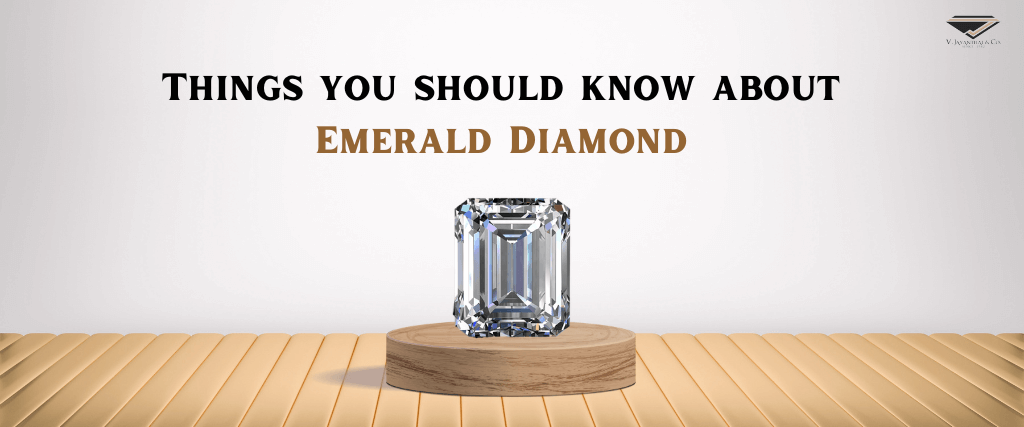
Whether you're treating yourself or shopping for an emerald-cut engagement ring for someone else, look no further for help choosing your perfect emerald-cut diamond! Below, we’ll go over the definition of an emerald-cut diamond and detail what you should consider when shopping for an emerald-cut diamond.
Emerald-cut diamonds are step-cut diamonds, meaning they have long parallel facets with a mirrored staircase vibe. When viewed from above, an emerald-cut diamond seems to be a rectangle with rounded sides. Although square emerald diamonds are less common, they still exist. For added durability, the corners of both forms are chopped. It is uncommon to find emerald-cut diamonds in jewellery. An emerald-cut diamond is a popular option for individuals seeking a larger stone without paying a high price point since it typically seems bigger than other shaped diamonds of the same carat weight. Celebrities frequently choose emerald cuts.
Our best advice for purchasing an emerald-cut diamond is to realize the significance of clarity for this shape. One of the 4Cs of diamond quality, clarity, is a grade that can reveal a diamond's degree of flaws. When diamonds are created naturally in the crust of the earth, they may be subjected to substances that give them imperfections on the outside or the inside.
With many brilliant cuts, like the round brilliant cut, high clarity isn’t always extremely important. This is because the brilliant cut style features numerous small facets that make it harder to see inside the diamond. On the other hand, emerald-cut diamonds are step-cut with large, linear, open facets. Because it is so simple to see within an emerald-cut diamond, clarity is more crucial. Because of this, many experts recommend making sure your emerald-cut diamond is eye-clean, which means there are no flaws visible to the naked eye.
Generally, VVS1-clarity diamonds and above will be eye-clean. Though you can sometimes find lower-clarity diamonds that are also eye-clean, if the diamond has been given a VVS1, VVS2, or VS1 clarity grade, it will be eye-clean. Additionally, while less frequently found, eye-clean diamonds can be found in grades as low as VS2, SI1, or SI2.
Diamonds are graded for color from D (colorless) to Z (champagne tones). Just like with clarity, that wide open table on emerald-cut diamonds shows a diamond's color more than with other diamond shapes.
However, keep in mind that each stone's color differs, and in the end, it all comes down to what you adore. Choose what you're drawn to first and worry about the grade second. Often, multiple color grades will look exactly the same to the naked eye.
Not to mention that diamonds are graded by humans, and different diamond graders could give the exact same stone completely different grades - there's an element of subjectivity.
The true indicator of a diamond's beauty is its cut. A well-cut diamond will shine brightly in direct light and luminize in low light.
The best place to start is to look at factors like polish and symmetry, table (diamond top) percentage, and depth percentage. For guidance on where to start with cut quality, see the table below.
If you're going cross-eyed looking at our chart, book a free consult with us to talk diamonds. You won't need to worry about selecting stones yourself if you're working with us to create bespoke work since we'll choose the most beautiful stone that fits your budget.
Emerald-cut diamonds can have many different length-to-width ratios. An emerald-cut diamond's proportions can vary, from long and thin to square, depending on this ratio. Since this ratio will provide the traditional emerald-cut diamond appearance, many people believe that a ratio of 1.45 to 1.55 is best for emerald cut diamonds. The "best" or "perfect" emerald-cut diamond ratio does not exist, nevertheless. If you love the look of the elongated shape of a slimmer emerald-cut diamond, go for a higher ratio. Alternatively, if you love the look of a more square-shaped emerald-cut diamond, choose one with a lower ratio.
With a delicious art-deco, Great Gatsby energy, emerald-cut diamonds never lose their luster. They feel eternally modern with their stretched dimensions and crisp geometric lines while nodding to bygone eras with their delicate candlelight shimmer.
Emerald-cut diamonds are about 10–15% less expensive than round brilliant diamonds of the same quality and carat weight.
Compared to other forms, the emerald cut uses less diamond, saving money and improving sustainability. Also, as a more unique choice, the demand is lower, bringing the price down—a plus for everyone who loves to go against the grain.
Those cut corners are more than just drama; they help prevent damage that can happen with sharp, pointed corners, like on a princess-cut diamond.
So, if you're extra active and want to stay safe, we'd love an emerald-cut diamond for you.
Who doesn't like the idea that an emerald-cut diamond will appear substantially bigger when placed next to a round brilliant diamond of the same carat weight?
Step-cut stones have less depth than brilliant cuts, so more weight is at the top, making it look larger from above.
With their elongated proportions, emerald cuts can slim and lengthen the look of your finger when set north-west. We do love an east-west emerald cut, though. Decisions, decisions.
A brilliant-cut diamond sparkles continuously like a disco ball, whereas an emerald-cut diamond occasionally emits blindingly intense bursts of light interspersed with a more subdued brightness. We love a surprise shining moment.
The simple answer is no. An engagement ring with an emerald cut will be cheaper than an engagement ring with a round diamond (and cheaper than most other shapes). Compared to other cuts, emerald cuts are much less expensive per carat than round diamonds. This is due to two factors: lower demand for emerald cuts and a higher yield on cutting (you lose the least amount of weight when cutting a rough diamond into a polished emerald cut).
However, things are not that easy. Emerald cuts are less expensive, yes. But when selecting an emerald cut, you also need to be stricter. Emerald cuts do not conceal inclusions as effectively as other cuts because of their glassy nature. When choosing a diamond for one of our readers, we often look for SI1 or SI2 clarity ratings. When choosing emerald cuts, we often go for clarity grades of VS2 or even VS1.
Take a look at this Blue Nile emerald cut. Normally, a diamond with SI1 clarity would be eye-clean. Unfortunately, the inclusion is evident to the human eye because of the huge table and the glass-like appearance. Despite this, emerald cuts are still a good option. We already noted that emerald cuts cost less per carat. Even with improved clarity, you can still find a fantastic deal. Having said that, you may still locate an emerald-cut diamond that is very expensive.
Emerald cuts go well with a variety of settings, but they go especially well with modest ones. Emerald cuts are ideal for three-stone settings and work well with solitaire and simple pave settings.
A well-proportioned Emerald Cut has a "hall of mirrors" look that is amplified by a solitaire setting that allows a lot of light to enter the diamond. It elegantly displays the distinctive design of an emerald diamond. An elegant emerald cut and a simple solitaire setting are very difficult to go wrong with.
See this traditional four-prong solitaire engagement ring with an emerald-cut diamond from Blue Nile for ideas.
Your ring will stand out more in a pavé setting without pulling attention away from the emerald diamond at the centre. The accent diamonds give the ring some flair while enhancing the fire of the centre stone.
See how the emerald cut might look in a pavé setting in this James Allen tiny pavé engagement ring made of 14K white gold.
Emerald diamonds look stunning when set in a three-stone design as well. The two lesser stones that are placed on either side of the central emerald help highlight and accentuate its brilliance.
The long, straight facets of the emerald are beautifully contrasted by brilliant-cut diamonds on either side, as in this marquise-shaped three-stone ring by James Allen.
For a sleek and sophisticated appearance, you can also surround the emerald with baguette diamonds, as seen in the example below from James Allen.
Asschers and emeralds are the same. The ratio of length to breadth is the only noticeable variation. Asscher cuts are often square, whereas emerald cuts are typically rectangular. There is no distinction between the two in terms of quality or worth. Everything comes down to taste or personal choice. Asscher and emerald cuts are both preferred options for engagement rings and other jewellery. Asscher cuts' square shape gives them a classic feel, while emerald cuts' rectangular shape may produce an appearance that is sleek and exquisite. The choice between the two ultimately boils down to personal preference and the intended visual result.
Diamonds with an emerald cut have an attractive form and distinctive step cuts. For those seeking a larger-appearing diamond without paying a high price, emerald cuts are a fantastic option. You can get emerald-cut diamonds of the highest caliber at V. Jayantilal & Co. for a reasonable price. We advise having a professional inspect your diamond before buying since emerald-cut diamonds need a close examination of the cut quality. Contact our professionals now for help choosing the ideal emerald-cut diamond.
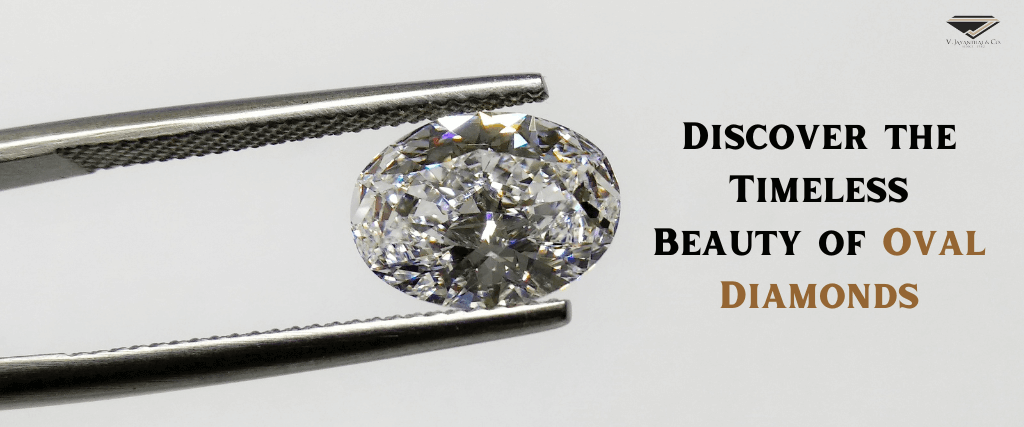
One of those timeless cuts, The Oval diamond, needs little introduction. Similar to the Round diamond, it is capable of speaking for itself and persuading many customers that it is the best option for them. Contrary to the round, it's a fantastic form to take into account if you want to deviate from "the norm" without going too far in the other direction. An oval diamond features an extended round form with a unique twist on understated beauty. Its fire may equal that of a round brilliant when it is faceted in a brilliant manner. The most typical facet configuration for an oval diamond is eight bezel facets on the crown and eight primary facets on the pavilion.
Oval diamonds are popular with many individuals for the following persuasive reasons: Oval diamonds might look bigger to the eye than round diamonds of the same carat weight because they have a larger surface area. The finger may appear longer due to the oval shape. In addition, because an oval diamond lacks sharp angles or corners, it is less likely to chip than other exquisite shapes. Obviously, there’s a lot more to know about the Oval cut than that, but extolling the virtues of this classic cut is certainly a great place to start.
One of the earliest types of diamonds is the oval. Lazare Kaplan, a Russian diamond cutter, improved the form in the 1960s. For the most dazzling, full-of-fire oval-cut diamond, he invented the cutting technique still in use today. Before designing the Modern Oval Cut, Kaplan gained a reputation for his extraordinary talents in cleaving, a procedure in which fractured or terribly defective diamonds are cut into smaller, minimally included gems. Inarguably one of the best-known diamonds in the world, the Koh-I-Noor, or ‘mountain of light, has featured an Oval cut since the mid-nineteenth century. Weighing 105.602 carats, the diamond is now in the possession of Queen Elizabeth II and resides in the Tower of London. Thousands of people have flocked to see it and the incredible glitter that the Oval cut offers throughout the years.
There are several options for settings for engagement rings with oval diamonds. And any option can provide a noticeably distinct appearance. Here are some options.
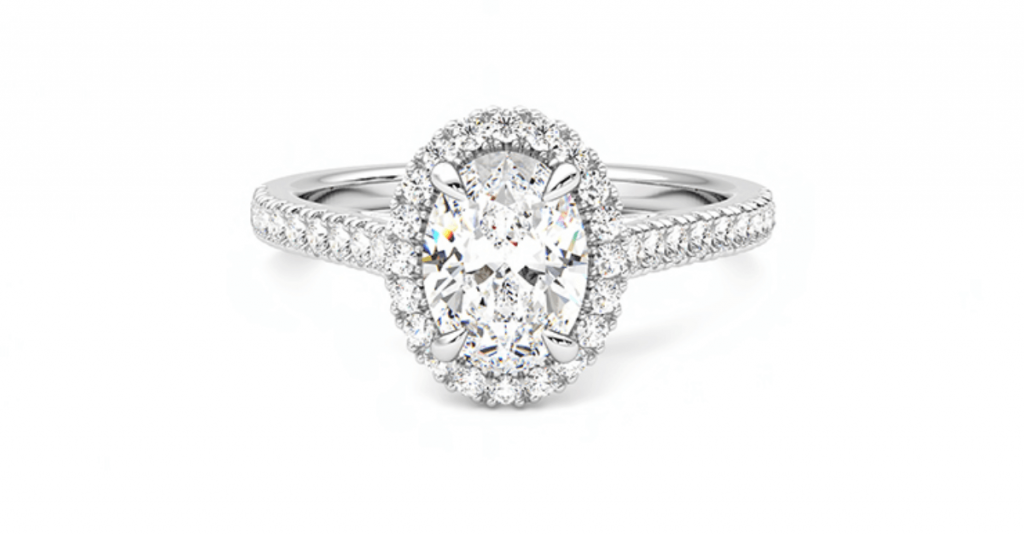
The circular centre stone is surrounded by a stunning halo of lesser diamonds. It draws attention to the form and gives the diamond a bigger appearance. A striking appearance may be achieved by selecting a unique metal colour or side stone.
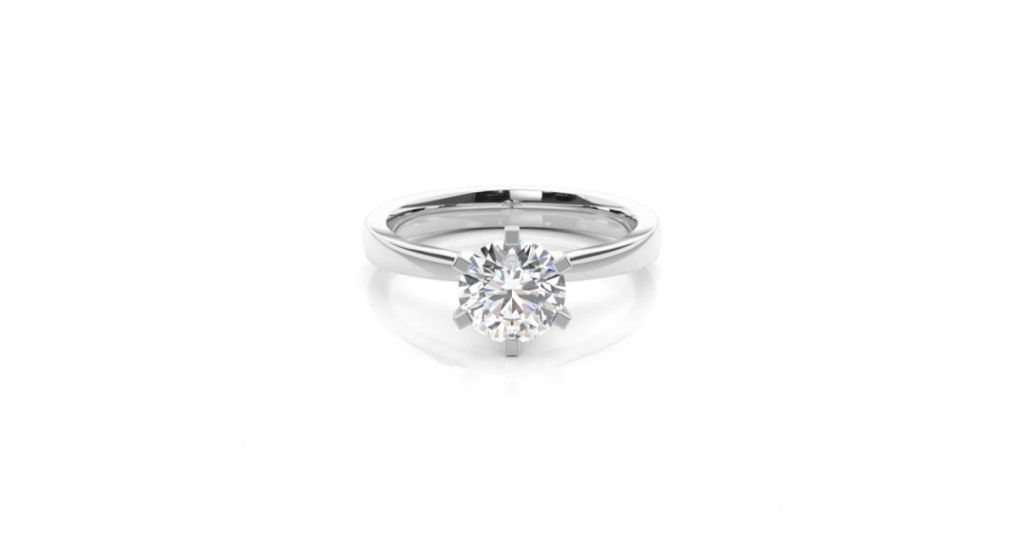
A decent setting for an oval diamond is a prong setting. They not only shield the diamond from damage, but they may also provide height, lifting the stone above the band and catching the viewer's attention.
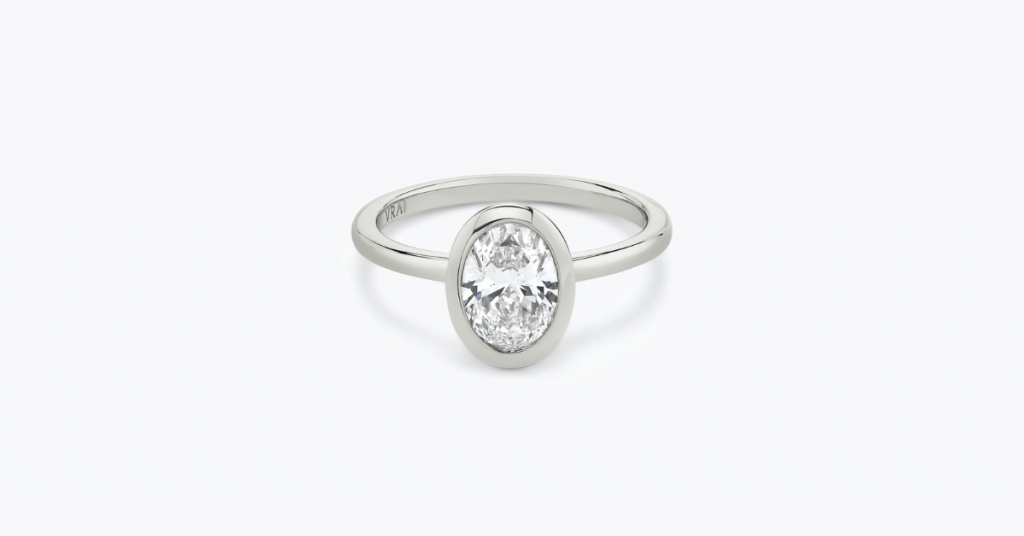
If you lead an active lifestyle, a bezel setting, which entirely encloses the diamond's edge in metal, is an excellent option. It’s an effective way to protect the diamond and also enhances the beauty of the oval shape.
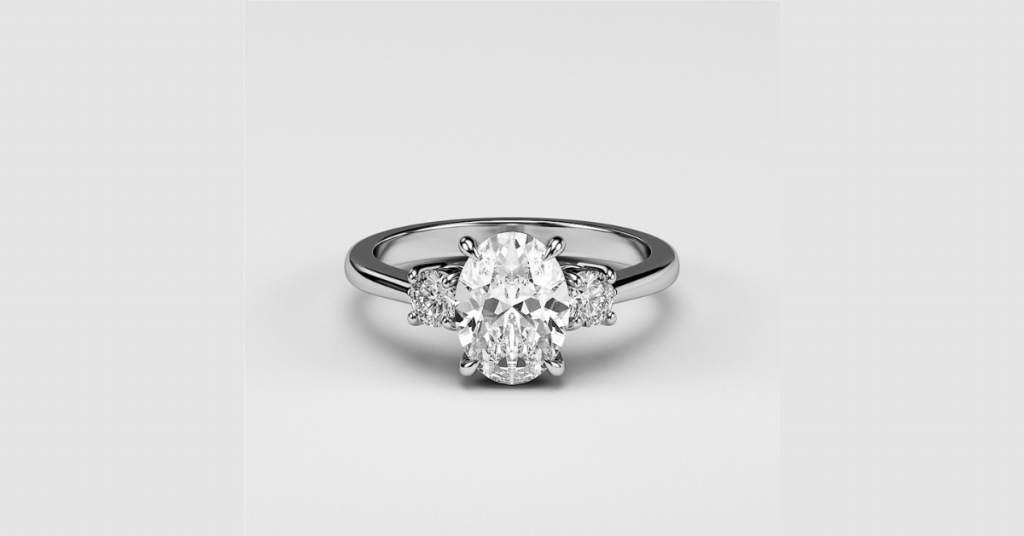
Almost any side stone looks good with an oval diamond. Its form is echoed by half-moon diamonds, which makes them a desirable option. Baguettes and tapering baguettes, as well as coloured gems, provide a chance to establish contrast. Choose side stones that are within one or two colour grades of the main diamond to avoid competing with its beauty if you want your diamond side stones to complement the centre oval.
The most accurate determinant of a diamond's brilliance, brightness, and overall beauty is its cut, which is the most crucial C of all.
The GIA does not assign oval diamonds the same overall cut grade as it does round brilliants, like all fancy cut diamonds. But all is not lost, since there are many more statistics that may be used to describe a diamond's cut. See our table below for a starting point for cut quality.
Remember that although though statistics are an excellent place to start to weed out low-quality diamonds, your best chance is always to see a diamond in person or on video and work with a reputable jeweller to locate the finest quality diamond in your price range. Oval diamonds are particularly arbitrary, and beauty is genuinely in the eye of the beholder (rather than the numbers).
Oval cut diamonds show color more than other diamond shapes, so you'll want to opt for a higher color grade to get a certain look - whether that be cool and colorless or sunny champagne. The larger the diamond, the more obvious the color differences will be.
However, the distinctions between two (or even three) colour classes are frequently indiscernible to the unaided eye, so put your attention on choosing the diamond colour that you adore visually rather than spending more money for a barely noticeable letter grade.
Carat refers to a diamond's weight and not its size as many people believe. Thanks to their elongated shape, oval cut diamonds tend to look bigger for their carat weight vs other diamond shapes like a round cut diamond.
While sizes vary depending on how a stone is cut, a one-carat round diamond usually measures 6.5 x 6.5 mm, whereas an average oval cut diamond is usually 7.7 x 5.7mm - the extra height provides the impression that it is bigger. Therefore, think about an oval cut if you want a diamond that appears larger than its actual carat weight.
The quantity of imperfections or flaws in a diamond is referred to as clarity. The oval shape and superb cutting help oval-cut diamonds to effectively conceal flaws. This implies that you may choose a diamond with a lesser clarity grade and yet have it be eye-clean. Now you're free to spend your budget on more important factors, like cuts.
Remember that imperfections closer to the margins of the stone will be easier to conceal than those closer to the centre.
Flawless (FL): No inclusions or blemishes can be seen with 10x magnification.
Internally Flawless (IF) - With a 10x magnification, several imperfections (but no inclusions) are visible.
Very, Very Slightly Included (VVS1 and VVS2) - Under a 10x magnification, inclusions are difficult to notice.
Very Slightly Included (VS1 and VS2) - Minor inclusions can be seen under 10x magnification
Slightly Included (SI1 and SI2) - inclusions that are visible at a 10x magnification
Included (I1, I2, and I3) - Obvious inclusions under 10× magnification
When looking for an oval diamond, consult the 4Cs of diamond quality. Oval diamonds are judged for their carat weight, colour, and clarity using the same standards as round brilliants. This might help you narrow down your search.
When viewing oval diamonds, keep proportion in mind. According to a thorough study of form preferences done by GIA in 2009, consumers and industry experts tend to favour a longer oval shape. According to the poll, ovals with a length to width ratio of 1.7:1 were the most common shape. You won't often find one since it is impractical to cut such lengthy oval diamonds from the raw rough. Ovals with ratios between 1.3:1 and 1.4:1 are more common.
In order to create the beauty of an oval diamond, symmetry is crucial. Draw a line along the centre of an oval diamond to see if it is symmetrical. The two sides' faceting and form should be identical. Next, trace a hypothetical line across the oval's centre. Again, the two parts should have the same faceting and form.
Look for an oval diamond with a lovely contour and sections that are evenly spaced apart. It is beneficial to contrast many various oval diamonds in order to pick one that appeals to you.
The pavilion and crown come together at the girdle. It serves as the diamond's setting edge and defines the diamond's perimeter. Rounds and fancy shapes both use the same criteria to determine girdle thickness. Make sure to review the percentage diagram in the diamond's GIA Diamond Grading Report. Indicating whether the girdle is excessively thick or thin, the figure will display the stone's average girdle thickness percentage. Overly thick girdles can make a diamond heavier than its face-up appearance suggests, while tiny girdles can make damage like chipping more likely.
A seemingly dull or darker core that resembles a black bow tie is known as the "bow tie effect." It is a location where light leaks rather than being reflected. The bow tie effect reduces diamond brilliance, although it only shows up when the oval cut is too shallow or deep. The presence of a bow tie will drive down the price of a loose diamond. A bow tie is caused by an issue with the diamond’s facets, which causes an area of reduced light within the centre of the diamond. The facets of a diamond work like a series of mirrors to reflect light back into your eye from everywhere around you. The dark contrast you observe as you gaze at the stone is a reflection of your head and shoulders, which are obstructing light from reaching the diamond. The bow tie will be more obvious the closer your face is to the diamond. If the diamond is cut correctly, the bow tie will be small, but once you are in front of the diamond, there will always be some measure of a bow tie.
Overall, oval-cut diamond rings have a bigger, longer appearance than round brilliant diamond rings but nevertheless have a similar level of brightness and scintillation. They go well with rings that have bigger accent stones since they are beautiful and feminine. Oval diamond forms of the highest caliber are offered at competitive prices by V. Jayantilal & Co.

